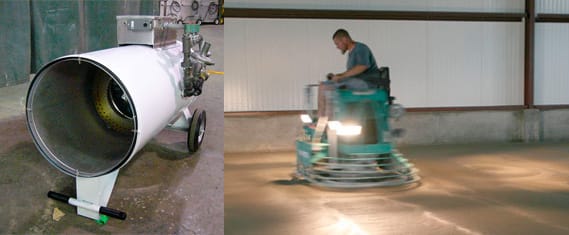“My head hurts and I feel dizzy.” –That was my response to the job superintendent as he asked me about the water service line I was installing in a new warehouse building just four days ago.
If you had been standing there you can imagine his frustration as he was really asking a yes or no question. Just as my response was heard the rather grotesque sounds of two concrete workers vomiting nearby had each of us in a state of confusion and quickly in worry mode. This was the direct result of carbon monoxide (CO) exposure and all three of us were in definite need of fresh air.
These were the cause of our problem situation. The combination of gasoline engines (power trowel) running inside and the lack of enough combustion air and venting of the temporary heater made for potentially deadly mix.
Normally a heavy duty flexible duct is attached to the backside of the job heater that brings in air from the outside, this one had that but it was removed when the heater was moved to accommodate a delivery of materials and was never reattached. The weather here has turned cold and the concrete mix being poured was high in chloride for a fast set. There were three large overhead doors opened half-way as an attempt to vent the area; add the huge heater blasting mega Btu’s and everything should go as planned. But we already know things didn’t turn out that way.
I can’t say exactly why the area wasn’t getting the proper venting we needed, I can only guess that wind from the outside was effecting the plan to the end result of a few guys having been exposed for too long to high levels of carbon monoxide.
“Carbon monoxide (CO) is a poisonous, colorless, odorless, and tasteless gas. Although it has no detectable odor, CO is often mixed with other gases that do have an odor. So, you can inhale carbon monoxide right along with gases that you can smell and not even know that CO is present.” –OSHA
Information about CO is readily available from trusted sources such as the Occupational Safety & Health Administration (OSHA) online. The explanation is taken directly from an OSHA fact sheet you can download as a PDF.
This situation has reminded me of the importance of knowing and monitoring my surroundings while on the job. I can only speak for myself when I say that I tend to take for granted that I’m safe from things like this happening to me. I think a lot of assume that no one else wishes to find themselves in a dangerous situation so, they must be doing everything they can to work safely and in return we’re probably okay too. Seemingly that was the case in this situation but things didn’t exactly work out that way.
It took almost two full days for my headache to go away. I consulted with a close friend who is an emergency room doctor about my experience and symptoms. He gave me the go ahead to go about my business as usual with the warning that it could’ve been a lot worse and that there is little they can do to make things better. Time would have to run its course for me. I’m glad to say it has and I have been rid of all the symptoms/effects of the poisoning situation.
I started researching online the different types of Personal Safety Gas Monitors; there are a lot to choose from. Have you used one of these devices? Can give me a recommendation of a monitor you have used/liked? I’d appreciate any comments you have to add.





Join the conversation: